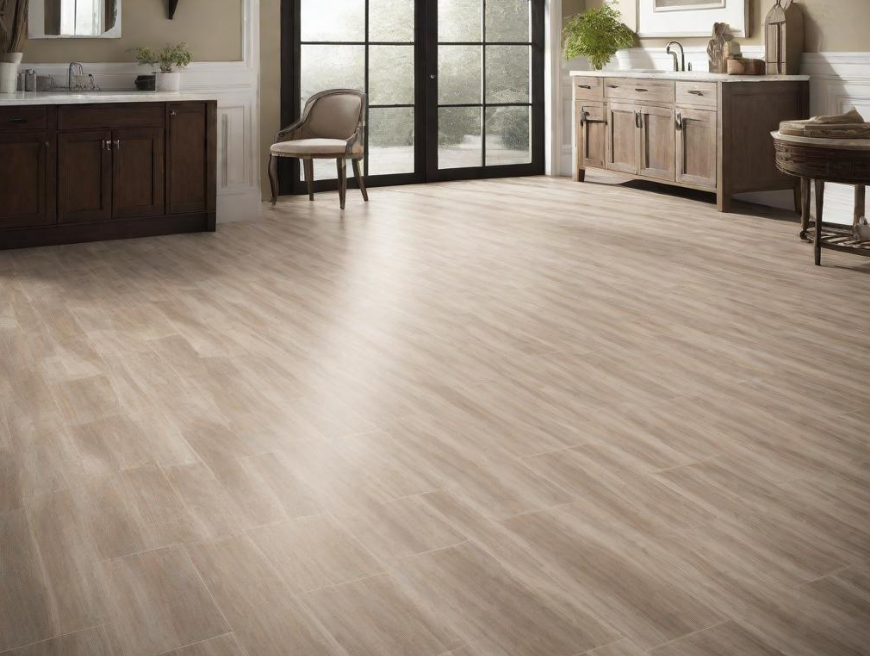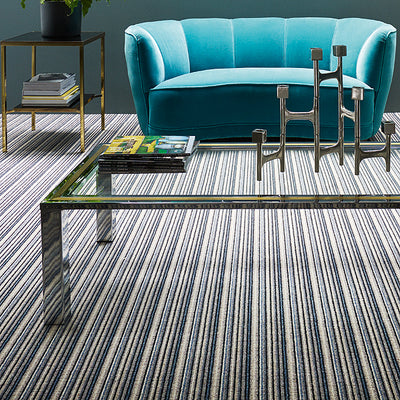
Luxury Vinyl Tiles vs Ceramic Tiles: Which is the Best Flooring Option for Your Home?
Quick Links
Pros and cons of Luxury Vinyl Tiles
Pros and cons of Ceramic Tiles
Durability and lifespan comparison between LVT and Ceramic Tiles
Maintenance and cleaning requirements for LVT and Ceramic Tiles
Cost comparison of LVT and Ceramic Tiles
Design and aesthetic considerations for LVT and Ceramic Tiles
Environmental impact of LVT and Ceramic Tiles
Installation process and ease of installation for LVT and Ceramic Tiles
Why Choose Carpets Online store near you for Vinyl Flooring?
Are you struggling to decide between luxury vinyl tiles (LVT) and ceramic tiles for your home flooring? With so many options available, making the right choice can be overwhelming. But fear not, we're here to help. In this article, we'll compare LVT and ceramic tiles and weigh the pros and cons of each so you can make an informed decision.
LVT is a popular choice due to its versatility and durability. It resembles the look of natural materials like hardwood or stone, but at a fraction of the cost. It is also water-resistant, making it a great option for kitchens and bathrooms. On the other hand, ceramic tiles are known for their timeless beauty and durability. They come in a wide variety of colours, patterns, and finishes, allowing you to create a unique and personalised look.
So, which is the best flooring option for your home? Keep reading to find out! We'll delve deeper into the features, benefits, and drawbacks of both LVT and ceramic tiles. By the end of this article, you'll have a clear understanding of which flooring option suits your needs and preferences.
Pros and cons of Luxury Vinyl Tiles
When it comes to luxury vinyl tiles (LVT), there are several advantages that make them a popular choice for homeowners. First and foremost, LVT offers incredible versatility. It can mimic the look of natural materials like hardwood or stone, but at a fraction of the cost. This means you can achieve the aesthetic you desire without breaking the bank. Additionally, LVT is available in a wide range of colours, patterns, and finishes, allowing you to find the perfect fit for your home decor.
Another major advantage of LVT is its durability. LVT is designed to withstand heavy foot traffic, making them a suitable choice for high-traffic areas such as entryways and living rooms. They are also water-resistant, which is particularly beneficial for rooms prone to moisture like kitchens and bathrooms. This feature ensures that your floors remain in top condition even in the face of spills and accidents.
However, it's important to consider the potential drawbacks of LVT as well. While it is durable, it may not be as long-lasting as ceramic tiles. Over time, LVT can show signs of wear and tear, especially in areas with heavy use. Additionally, while LVT is water-resistant, it is not completely waterproof. Prolonged exposure to moisture can still cause damage, so it's essential to promptly clean up any spills.
Overall, luxury vinyl tiles offer an affordable and versatile flooring option that is suitable for a wide range of applications. They provide the look of natural materials with added durability and water resistance. However, it's important to be mindful of their limitations in terms of longevity and water resistance.
Pros and cons of Ceramic Tiles
Ceramic tiles have long been admired for their timeless beauty and durability. These tiles are made from natural clay that is shaped and fired at high temperatures to create a hard, dense material. One of the key advantages of ceramic tiles is their wide range of design options. They come in various colours, patterns, and finishes, allowing you to create a unique and personalised look for your home. Whether you prefer a classic or contemporary style, ceramic tiles offer endless possibilities.
In addition to their aesthetic appeal, ceramic tiles are highly durable. They can withstand heavy foot traffic and are resistant to scratches and stains. This makes them an excellent choice for areas with high use, such as hallways and dining rooms. Furthermore, ceramic tiles are known for their ability to retain their colour and finish over time, ensuring that your floors look beautiful for years to come.
However, there are a few drawbacks to consider when it comes to ceramic tiles. One of the main concerns is their vulnerability to impact. While they are durable, ceramic tiles can crack or chip if a heavy object is dropped on them. This can be a significant disadvantage, particularly in households with young children or pets. Additionally, ceramic tiles can feel cold underfoot, which may not be desirable in colder climates.
In summary, ceramic tiles offer a timeless and durable flooring option with a wide range of design possibilities. They are resistant to scratches and stains and can withstand heavy foot traffic. However, their vulnerability to impact and coldness underfoot should be taken into consideration.
Durability and lifespan comparison between LVT and Ceramic Tiles
When it comes to durability and lifespan, both luxury vinyl tiles (LVT) and ceramic tiles have their strengths and weaknesses. LVT is known for its durability and ability to withstand heavy foot traffic. It is resistant to scratches and stains, making it a suitable choice for busy households. However, over time, LVT can show signs of wear and tear, especially in areas with heavy use. It may require replacement or repairs after a certain period.
On the other hand, ceramic tiles are extremely durable and can last for decades when properly maintained. They are highly resistant to scratches, stains, and fading, ensuring that your floors maintain their beauty for a long time. However, as mentioned earlier, ceramic tiles are susceptible to cracking or chipping if a heavy object is dropped on them. This can be a significant factor to consider, especially in households with children or pets. Advancements in technology have led to the development of more durable LVT options, which can rival the lifespan of ceramic tiles.
Ultimately, the choice between LVT and ceramic tiles depends on your specific needs and priorities. If you prioritise versatility and affordability, LVT can still offer a durable solution for your home and has become very popular over the last few years. Tiles, although prone to cracking and breaking due to impact, are still the preferred option for large kitchens.
Maintenance and cleaning requirements for LVT and Ceramic Tiles
When it comes to maintenance and cleaning, both luxury vinyl tiles (LVT) and ceramic tiles have their own requirements.
LVT is relatively easy to maintain. Regular sweeping or vacuuming, along with occasional mopping using a mild detergent, is usually sufficient to keep LVT floors clean. It's important to avoid using abrasive cleaners or excessive water, as they can damage the tiles. Additionally, placing doormats at entryways can help prevent dirt and debris from being tracked onto the LVT surface.
Ceramic tiles also require regular sweeping or vacuuming to remove loose dirt and debris. Unlike LVT, ceramic tiles can withstand more aggressive cleaning methods, such as scrubbing with a neutral cleaner or using a steam mop. However, it's essential to avoid using harsh chemicals or abrasive materials that can scratch the tiles. Additionally, grout lines should be periodically sealed to prevent staining and maintain their appearance.
In terms of maintenance, LVT has an advantage over ceramic tiles due to its resistance to scratches and stains. LVT does not require sealing or regrouting, which can be time-consuming and labour-intensive tasks for ceramic tiles. However, it's worth noting that if a ceramic tile becomes damaged, it can be replaced individually, whereas LVT often requires the replacement of an entire section.
When considering maintenance and cleaning requirements, it's important to assess your lifestyle and preferences. If you prefer a low-maintenance option, LVT may be more suitable. However, if you are willing to invest more time and effort into cleaning and maintenance, ceramic tiles can provide a beautiful and long-lasting flooring solution.
Cost comparison of LVT and Ceramic Tiles
Cost is an important consideration when choosing between luxury vinyl tiles (LVT) and ceramic tiles for your home flooring. LVT is generally more affordable than ceramic tiles, making it an attractive option for budget-conscious homeowners. It offers the look of natural materials like hardwood or stone at a fraction of the cost. Additionally, LVT installation is often less expensive, as it does not require specialised tools or adhesives.
On the other hand, ceramic tiles tend to have a higher upfront cost. The cost of ceramic tiles can vary depending on factors such as size, design, and quality. Additionally, ceramic tile installation can be more labour-intensive and time-consuming, which can contribute to higher installation costs. However, it's worth noting that ceramic tiles have a longer lifespan compared to LVT, which can offset the initial cost over time.
When considering the cost of LVT and ceramic tiles, it's important to assess your budget and long-term financial goals. If affordability is a top priority, LVT may be the better option. However, if you are looking for a long-term investment, the higher upfront cost of ceramic tiles may be justifiable.
Design and aesthetic considerations for LVT and Ceramic Tiles
When it comes to design and aesthetics, both luxury vinyl tiles (LVT) and ceramic tiles offer a wide range of options to suit different styles and preferences.
LVT is known for its ability to mimic the look of natural materials like hardwood or stone. It comes in various colours, patterns, and finishes, allowing you to create a unique and personalised look for your home. Whether you prefer a classic or contemporary style, LVT offers endless possibilities. Additionally, LVT can be cut into different shapes and sizes, giving you the flexibility to create intricate patterns or unique layouts.
Ceramic tiles, on the other hand, offer a timeless and elegant aesthetic. They come in a wide variety of colours, patterns, and finishes, giving you the freedom to create a look that suits your personal taste. From traditional to modern designs, ceramic tiles can enhance the overall aesthetic of your space. Additionally, ceramic tiles can be combined with different sizes and shapes to create visually appealing patterns or borders.
When making design and aesthetic considerations, it's important to assess your personal style and the overall theme of your home. LVT offers versatility and the ability to mimic natural materials, while ceramic tiles provide a classic and elegant look. Consider your preferences and the existing decor of your home to make the best choice for your flooring.
Environmental impact of LVT and Ceramic Tiles
In recent years, there has been an increased focus on sustainability and the environmental impact of various products, including flooring options. Both luxury vinyl tiles (LVT) and ceramic tiles have their own considerations in terms of their environmental footprint.
LVT is often considered a more environmentally friendly option compared to other flooring materials. Many LVT products are made from recycled materials, reducing the demand for new raw materials. Additionally, LVT production requires less energy and water compared to ceramic tiles. However, it's important to note that not all LVT products are created equal. Some may contain harmful chemicals or additives, so it's essential to choose products that have low volatile organic compound (VOC) emissions.
Ceramic tiles, on the other hand, are made from natural clay and minerals, which are abundant and renewable resources. They have a long lifespan, reducing the need for frequent replacements. However, ceramic tile production can be energy-intensive, particularly during the firing process. Additionally, the transportation of ceramic tiles from manufacturing facilities to the end consumer can contribute to carbon emissions.
When considering the environmental impact, it's important to weigh the advantages and disadvantages of both LVT and ceramic tiles. LVT offers the potential for recycled materials and lower energy consumption, while ceramic tiles utilise renewable resources. Additionally, proper disposal and recycling options should be considered for both types of tiles to minimise waste.
Installation process and ease of installation for LVT and Ceramic Tiles
The installation process and ease of installation are important factors to consider when choosing between luxury vinyl tiles (LVT) and ceramic tiles.
LVT is known for its ease of installation, making it a popular option for DIY enthusiasts. LVT can be installed using different methods, including loose lay, glue down, or click-lock systems. The click-lock system, in particular, allows for a straightforward installation process, as the tiles simply click together without the need for adhesives. This makes LVT a great choice for homeowners looking to tackle the installation themselves.
Ceramic tile installation, on the other hand, can be more complex and time-consuming. It often requires the use of specialised tools and adhesives. Additionally, the installation process involves preparing the subfloor, laying the tiles, and grouting the joints. This can be a labour-intensive task that may require professional assistance, especially for larger areas or intricate designs.
When considering the installation process, it's important to assess your DIY skills and the complexity of the project. If you are confident in your abilities and prefer a DIY approach, LVT may be the better option. However, if you prefer a professional installation or have a complex design in mind, ceramic tiles may be the more suitable choice.
Why Choose Carpets Online store near you for Vinyl Flooring?
Choosing the Carpets Online Store for vinyl flooring is like discovering a hidden treasure trove of comfort and style right at your fingertips. It's not just about upgrading your floors; it's about transforming your home into a sanctuary of warmth and luxury. The Carpets Online Store becomes a hub of inspiration, offering a diverse range of colours, patterns, and textures. You find yourself drawn to the exquisite details, the subtle nuances that make each vinyl flooring option unique. It's like choosing a piece of art that will become an integral part of your daily life.
In the end, choosing us for vinyl flooring is not just a practical decision; it's an emotional journey. It's about infusing your living space with character, about creating a haven where every step echoes a symphony of style and sophistication. So, go ahead, explore the online world of carpets on 50% discounts, and let your floors become a canvas for the emotions that define your home.
Conclusion: Choosing the best flooring option for your home
In conclusion, the choice between luxury vinyl tiles (LVT) and ceramic tiles depends on various factors, including durability, maintenance, cost, design, and installation. Both options offer their own advantages and disadvantages, so it's essential to assess your needs and priorities.
LVT provides versatility, affordability, and water resistance, making it a suitable option for many homeowners. However, it may not have the same longevity as ceramic tiles and requires proper maintenance to ensure its durability.
Ceramic tiles offer timeless beauty, durability, and a wide range of design options. They can last for decades when properly maintained but may be more expensive upfront and require professional installation.
Consider your lifestyle, budget, design preferences, and installation capabilities to make an informed decision. Ultimately, the best flooring option for your home is the one that meets your specific needs and enhances the overall aesthetic of your space.







